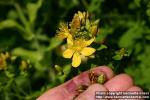The color of St. John's wort (Hypericum perforatum) is purple.
They've started to flower and I'll be picking them later this week, as I write this (about now, as you read this). That yellow flower (and particularly the flower bud) gives a dark red color if crushed.
 Pic: Red color from a yellow flower. And that color is a surefire way to make sure that yep, the plant under your fingers is a St. John's wort, one or the other Hypericum. And you can use them all -- all that give that color, that is.
Pic: Red color from a yellow flower. And that color is a surefire way to make sure that yep, the plant under your fingers is a St. John's wort, one or the other Hypericum. And you can use them all -- all that give that color, that is.
I haven't been able to get purple fingers from the rather large flowers of various garden species.
And in rainy summers, after a few rainy days, all I get from flowers (or even flower buds) is water.
In autumn, around September or so, the color fades as well.
But even given all that: this is what started me on herbs, back when I was knee-high. Because if red fingers from crushing a bright yellow flower isn't magic, I don't know what is.


Comments
Ohhhh....I just wrote up St
Ohhhh....I just wrote up St Johns wort on me blog myself today! Isn't it a LOVELY plant!
I put up my oil this weekend, and it's gone a deep ruby red infusing in the desert sunshine.
(though i did have to rescue it from certain doom when it began to get cloudy , windy and oh so rainy last night!)
ah, saint john's wort... I
ah, saint john's wort... I was just talking about applying the oil in last night's class for a chicken with nerve damage (yeah... really...). I was at a loss, though, to speculate as to whether photosensitivity would be an issue, in a chicken... you wouldn't perhaps, know?
Our sun is certainly hot
Our sun is certainly hot enough for deserts right now, but I'm still doing the waterbath infusion.
Infused oil of SJW has been used to protect against the sun; I dimly remember that it might catch some of the UV. Dunno if there's any science behind that, though.